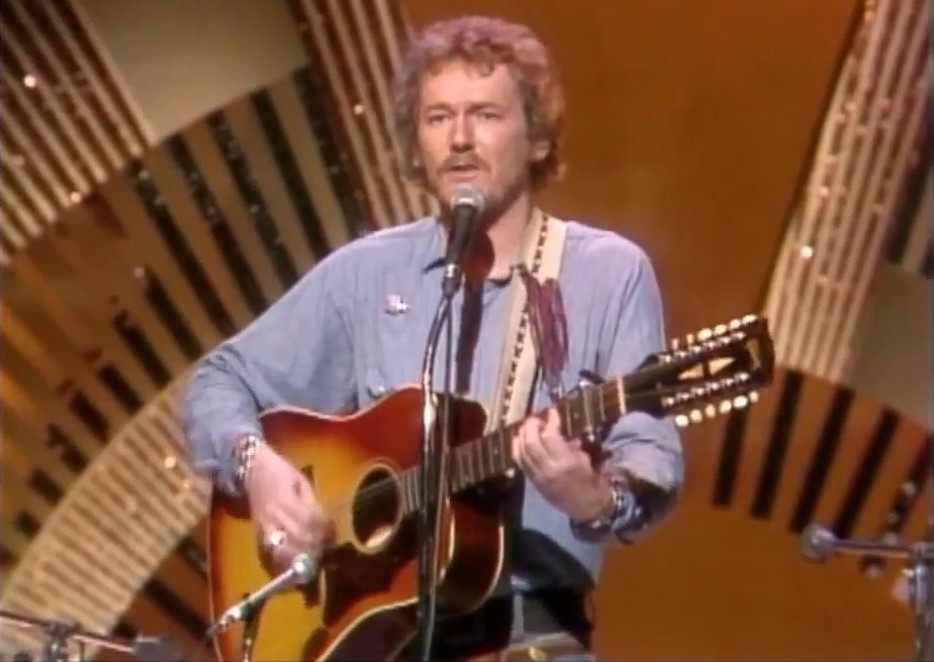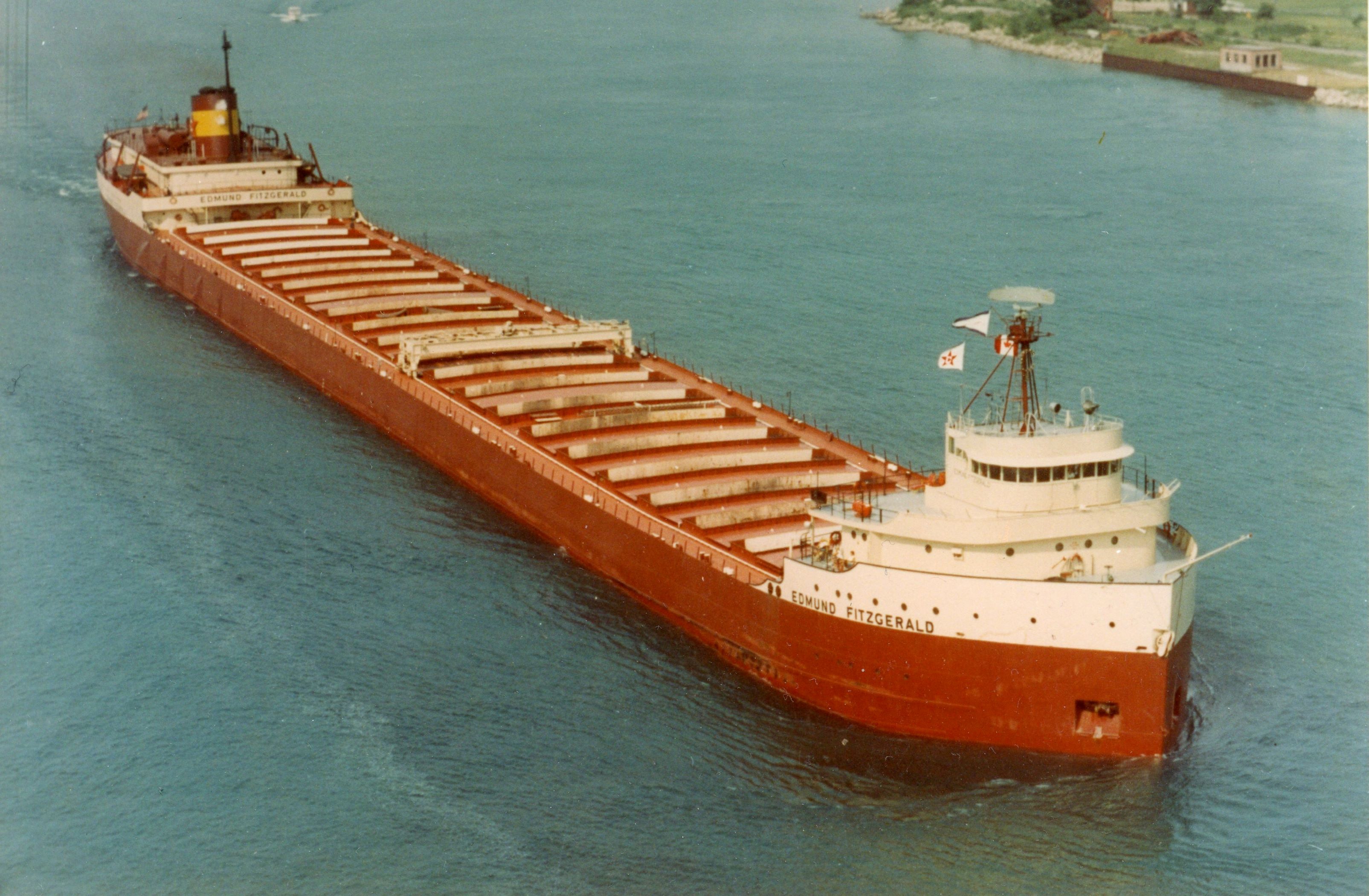
"Time has no beginnings and history has no bounds." Gordon Lightfoot continued touring into his eighties. He died May 1, 2023, but left behind a lifetime of memorable music.
A decade-plus of honing his craft, preceded by additional years of woodshedding—he was 27 when his debut album appeared in 1966—had prepared Lightfoot to deliver his masterwork. Produced by Lightfoot and his long-time collaborator Lenny Waronker, "The Wreck of the Edmund Fitzgerald" immediately entered the popular consciousness thanks to its brilliant treatment of a contemporary event framed in a compelling narrative style that allowed the visceral details to strike the listener with the stark and awesome power of the Great Lakes storm that doomed the ship. Salting the punch was the music, a loosely framed sea chantey—suggested further by Lightfoot's sing-song vocals—with percussion slapping like waves amidst the swell of Moog synthesizer, pedal steel, and keening electric guitar cutting through the air like the Witch of November herself.
More importantly, "The Wreck of the Edmund Fitzgerald" also led to a continuing interest in the Edmund Fitzgerald itself: The ship's bell was recovered from the wreck and replaced by one that listed all twenty-nine names of captain and crew; the original bell has been enshrined in a Great Lakes maritime museum. Although it's Lightfoot's best-known song to rock audiences, "Edmund Fitzgerald" epitomizes the intent of the best folk music—to encapsulate current circumstances without freezing them into a dated context. Given the song's immediacy and power decades later, Lightfoot can be said to have created a folk classic.
Growing up around London, Ontario, one of Canada's Tory strongholds, Gordon Lightfoot developed an early interest in folk music, and after a trek to Los Angeles to further his musical studies, he returned to Canada, where he impressed the notable Canadian folk duo Ian and Sylvia sufficiently enough to prompt them to introduce him to Albert Grossman, Bob Dylan's manager, who arranged a recording deal for him with United Artists.
Lightfoot's first album Lightfoot! focused on personal topics with songs such as "Early Morning Rain," which, perhaps as reward, became a Canadian Number One hit for Ian and Sylvia while demonstrating how accessible Lightfoot's songwriting, with its mature and intelligent lyrical outlook coupled with strong melodies and musical arrangements, was, as many of his songs, like Dylan's, attracted numerous cover versions (including by Dylan himself). Ironically, Lightfoot's best-known song from his debut is a cover of Ewan MacColl's "The First Time Ever I Saw Your Face," one of three covers on the album, although for the rest of his career his studio albums comprised almost exclusively his own compositions.
Indeed, his next album, The Way I Feel (United Artists, 1967), contained Gordon Lightfoot's quintessential Canadian song. Written to commemorate the Canadian centennial, a year-long celebration of the 100th anniversary of Canadian confederation in 1867, "Canadian Railroad Trilogy" was a stirring, impressionistic narrative of nation-building by railroad in the wilderness, namely, the Canadian Pacific Railway that by 1886 spanned Canada "from the Eastern shore to the Western strand." It established Lightfoot as an appealing, articulate chronicler of Canada in song although his earthy style was readily accessible to listeners of any nationality.
Looking like a cross between Darryl Sittler and Alex Trebek, Gordon Lightfoot embodied Canada with his stirring "Canadian Railroad Trilogy."
Much of that lay in Lightfoot's vague, allusive lyrical approach that, while vivid and descriptive, nevertheless suggested a polished veneer that lacked substance. "Black Day in July," written about 1967 civil unrest in Detroit and that appeared on Did She Mention My Name? (United Artists, 1968), conveyed topicality but no urgency, let alone a point of view, so while it might have avoided the stridency of contemporary protest music, neither did it display much depth or impact apart from being a well-done but politely empty song.
Lightfoot sounded stronger when he got his back up, or at least became engaged in his subject, as he did on 1968's Back Here on Earth (United Artists), which contained signs of Lightfoot's sharpening his skills: "Long Thin Line," a tale of a travelin' man, had engaging accessibility; "Cold Hands from New York" displayed vulnerability that didn't seem affected, as did the similarly autobiographical "Don't Beat Me Down"; and "Marie Christine" was a maritime story that pointed the way to "The Wreck of the Edmund Fitzgerald" even if its "shipwreck" was a romantic and sexual metaphor couched in sly, subtle ribaldry, wickedly refreshing and delightfully shocking to listeners accustomed to his seeming gentility.
By 1970, Lightfoot had parted company with United Artists for Reprise, where he was united with producer Lenny Waronker. His first album for the label, If You Could Read My Mind (1970), had initially been released under the title Sit Down Young Stranger until "If You Could Read My Mind" became his first US hit, reaching the Billboard Hot 100 Top Five and remaining one of his best-known songs with its melancholy reflection of failed love (it had been written about the end of his first marriage). However, his other "title song," "Sit Down Young Stranger," found Lightfoot broaching topicality again, this time with a complex issue affecting both sides of the US-Canadian border: the arrival into Canada of American young men seeking to avoid military service, particularly in Vietnam. Lightfoot's personal tone addresses the issue obliquely, with understanding and even compassion, without—again—taking a stance.
Nevertheless, Lightfoot established himself as a major artist with the album and its hit title song, which cemented his métier as a perceptive, articulate observer of interpersonal interactions and separations. With 1974's Sundown (Reprise), he hit the top of the American album and singles charts as the brilliant title song displayed uncharacteristic yet welcome orneriness and grit, underscored by Red Shea's prominent electric guitar poking around those "back stairs" Lightfoot sings darkly about. "Sundown" was reputedly written about his girlfriend of the time, Cathy Smith, who would later attain lasting notoriety for administering the "speedball" (an injected cocaine and heroin mix) that killed actor-comedian John Belushi in 1982.
Then came Summertime Dream (Reprise, 1976), which contained "Edmund Fitzgerald" and marked the culmination of Gordon Lightfoot's commercial success. His recorded output began to slow by the 1980s although he remained a popular concert draw, particularly his near-annual round of shows at Toronto's Massey Hall, as he settled into emeritus status as one of the leading figures of folk-rock inspiring and influencing countless artists who followed in his wake.
Like many, it was "The Wreck of the Edmund Fitzgerald" that first introduced me to Gordon Lightfoot. Having been born on the shore of one Great Lake (Ontario), having later lived on the shore of another (Michigan), and having "swum" in Lake Superior, the "Gitchee Gumee" of the song (I was two years old and not only had parental help, I cannot even recall it), I was drawn to the familiarity I felt immediately from first hearing it.
More than that, though, I was spellbound by the narrative. Even when I first heard the song, before I had discovered my affinity for music in my teens, which I have been cultivating ever since, I knew, subconsciously and intuitively, that songs that have a story to tell, a clear narrative of beginning-middle-end, were of special interest to me.
Thus, in hindsight, Gordon's "Edmund Fitzgerald" planted the seed for my interest in "folk" music, a broad term that can also encompass blues and country music along with traditional music from other cultures and countries beyond my upbringing in (more or less) English-speaking North America.
The ship that inspired Gordon Lightfoot's signature song. The doomed SS Edmund Fitzgerald remains in our memories because of Lightfoot's masterful tribute to her plight.
Now, as a rocker, that interest lay dormant at least until my mid-twenties, after the "hormonal rush" of adolescence and young adulthood abated somewhat, which is when my musical interests and tastes began to broaden considerably. Even then, though, I still had to go through Neil Young and especially Bob Dylan before I began to discover an artist such as Woody Guthrie.
But now it is easy to see that Gordon's "Canadian Railroad Trilogy" is the Canadian equivalent to Guthrie's "This Land Is Your Land," which has several verses that are not found on the more popular releases of his nevertheless expansive, uplifting song: Both are paeans to a nation expressed in the plainspoken immediacy and unvarnished emotion that is the hallmark of the "common man," to borrow the second half to the title of Aaron Copland's celebrated "fanfare," which itself, though stirring, might be too grandiose to qualify as "folk."
It's the story that counts, and Gordon Lightfoot always had one to tell in his appealing, confident baritone register. The wealth of cover versions his songs inspire speaks to his universal ability to communicate easily to a broad spectrum of ears, hearts, and minds.
As someone whose preferences run to grittiness rather than glossiness, my favorites tend to be his earlier, punchier songs—the pugnacious "Boss Man," the edgy, itchy "Sundown," and the wry licentiousness of "Marie Christine"—but for sheer mastery of the form, my go-to Gordons remain "Canadian Railroad Trilogy" and the one that first alerted me to his presence, "The Wreck of the Edmund Fitzgerald."
With his passing, listening to any Gordon Lightfoot song will now imbue it with even more wistfulness, melancholy, and longing than it may have already, but that will quickly be counterbalanced by knowing that this thoughtful, talented, and perceptive artist had been "back here on Earth," to borrow his own album title, to make my life—and the lives of countless others who mourn now—richer with his abiding gift.


Comments powered by CComment